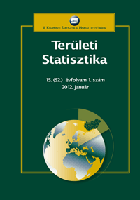A szomszédos országokban született népesség
területi mintázata Magyarországon, 2011, 2017
Spatial patterns of Hungarian residents born in neighbouring countries, 2011, 2017
Author(s): Áron Kincses, Géza TóthSubject(s): Social Sciences, Economy, Geography, Regional studies
Published by: Központi Statisztikai Hivatal
Keywords: population born abroad; territorial autocorrelation; international migration
Summary/Abstract: This study focuses on spatial approaches (rather than spatial analysis) by examining neighbourhood, local similarity as well as spatial locations and patterns. The authors through this methodological paper present how spatial autocorrelation can be used in territorial analysis on Hungarian residents born in neighbouring countries to answer the following questions: To what extent do other uses of space characterize different foreign affiliated resident groups? To what extent do immigrant populations form distinct groups, multi-district regions and arrays by citizenship? What is their spatial pattern? Which places have values similar to or different from those of neighbouring districts? How stable are they in time?The first part of the analysis models general spatial similarities for groups of Hungarian residents born in Austria, Romania, Serbia,Slovakia and Ukraine. The authors have shown that there is a positive trend in autocorrelation,with the formation of district groups where the foreign-affiliated population is grouped by citizenship. The second part used the Luc Anselin's Local Moran I method to quantify and map spatial autocorrelation. With this procedure,the authors were able to graphically isolate differences in the geographical location of populations involved in international migration.
Journal: Területi Statisztika
- Issue Year: 60/2020
- Issue No: 02
- Page Range: 155-178
- Page Count: 24
- Language: Hungarian

